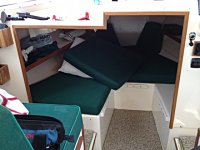jimandlaurie
New member
Kudos to you David and Pat for getting out the tools on this project. I used my chainsaw oops , I mean my laser-guided sabre saw cutting ours out . I went through 2 blades on it, just as you used 2 cutters on yours. It was tought stuff, but well worth the effort. The results are as you say excellent , and Admiral Laurie likes it!

